University Assignment: Granville Train Disaster Analysis Report
VerifiedAdded on 2022/12/19
|9
|2352
|142
Report
AI Summary
This report provides an in-depth analysis of the Granville train disaster, a significant railway accident in Australia. It details the incident, including the faulty safety breaches, such as overloaded trains and inadequate track maintenance, that contributed to the derailment and collapse of a road bridge onto the train. The report explores the reasons behind the accident, emphasizing the role of poor railway management and lack of safety precautions. It also outlines the changes made to railway policies and procedures following the disaster, focusing on improved safety measures, passenger capacity controls, and enhanced security protocols to prevent similar incidents. The report highlights the impact on Australian society and the lessons learned in safety and risk management.
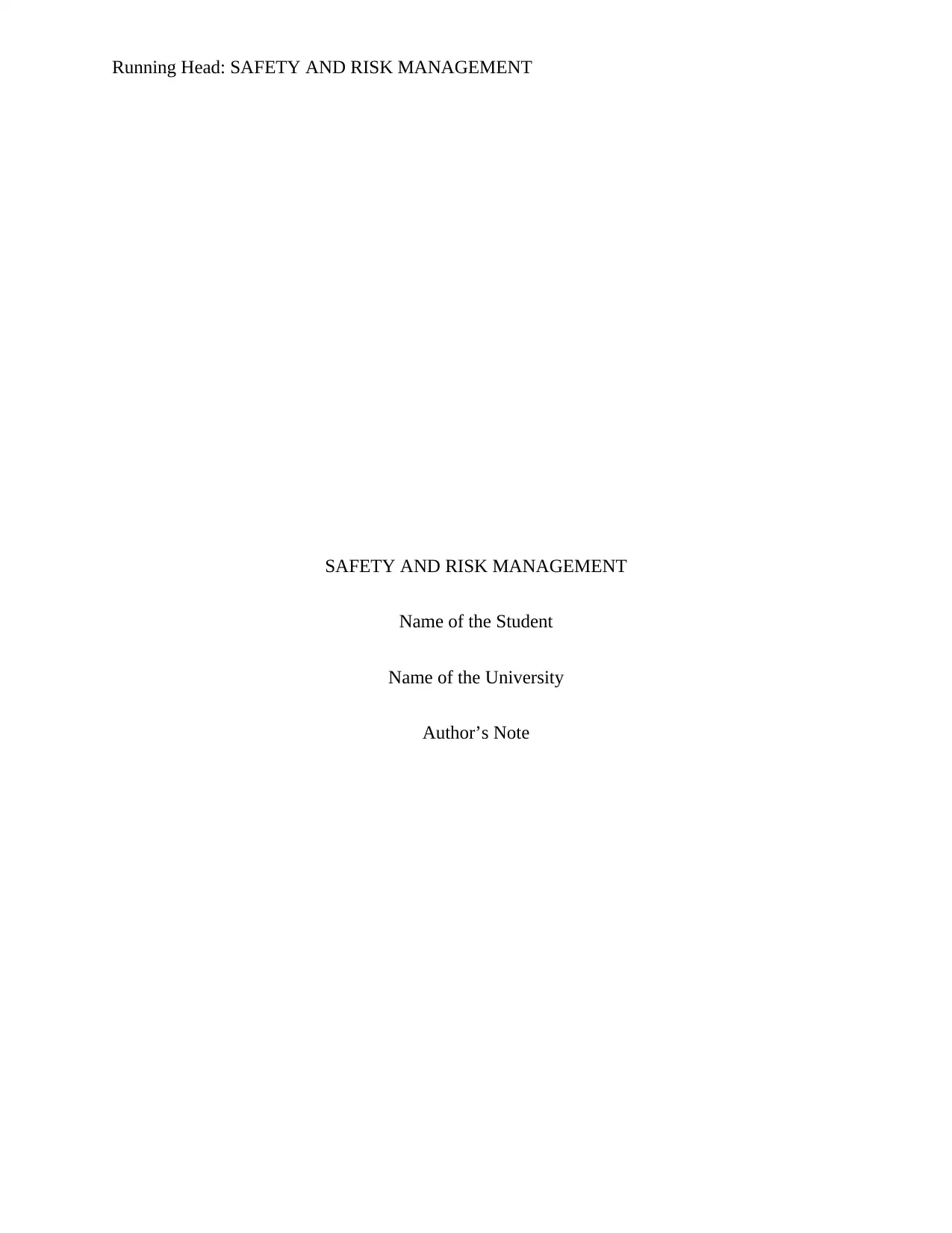
Running Head: SAFETY AND RISK MANAGEMENT
SAFETY AND RISK MANAGEMENT
Name of the Student
Name of the University
Author’s Note
SAFETY AND RISK MANAGEMENT
Name of the Student
Name of the University
Author’s Note
Paraphrase This Document
Need a fresh take? Get an instant paraphrase of this document with our AI Paraphraser
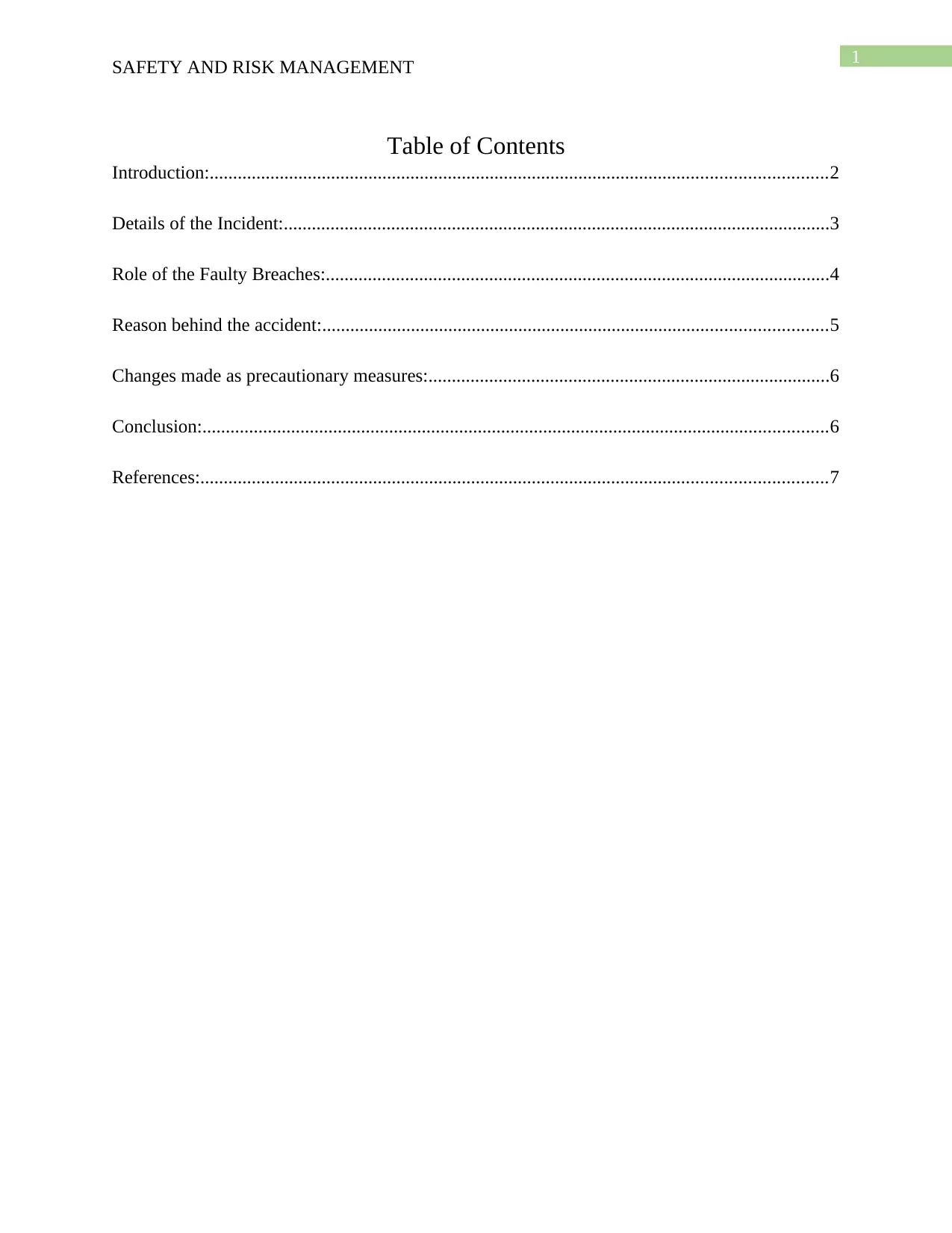
1
SAFETY AND RISK MANAGEMENT
Table of Contents
Introduction:....................................................................................................................................2
Details of the Incident:.....................................................................................................................3
Role of the Faulty Breaches:............................................................................................................4
Reason behind the accident:............................................................................................................5
Changes made as precautionary measures:......................................................................................6
Conclusion:......................................................................................................................................6
References:......................................................................................................................................7
SAFETY AND RISK MANAGEMENT
Table of Contents
Introduction:....................................................................................................................................2
Details of the Incident:.....................................................................................................................3
Role of the Faulty Breaches:............................................................................................................4
Reason behind the accident:............................................................................................................5
Changes made as precautionary measures:......................................................................................6
Conclusion:......................................................................................................................................6
References:......................................................................................................................................7

2
SAFETY AND RISK MANAGEMENT
Introduction:
One of the most horrifying incidents in the Australian accidents is the Granville Disaster.
It occurred in the year of 1977 on 18th of January. It was on Tuesday and it was rush hour, there
were a lot of people and boarding the train and most of the people were travelling for work. The
train was therefore overly crowded therefore, the train had problem in making steep turns. Thus,
the train has faulty case of the safety breaches that made the tracks of the train tracks vulnerable,
thus making it prone to the accident. Hence, the number of the people in the train was making the
train heavier and unable to therefore it was unable to make flexible turns. The bridge on which
the train was having pressure and the train got de-railed from its tracks and thus making it prone
to collapse (Rapattoni, Dauth, Muscat & Prasad, 2017, April). The incident occurred in the
suburbs of Granville, New South Wales. The train ran into the support of a road bridge that also
collapsed simultaneously. The bridge being derailed went out of control; hence, the train ran into
the road bridge, which collapsed on the two carriages of the train. The carriages was fully packed
with people and a lot of them were crushed to death in the very spot. The accident was fatal and
hence number of injuries as well as the death of people was a lot. It affected deeply in the social
and the public life of Australia, hence the people of Australia suffered a grave disaster after a
long time, with a great amount of loss of life. The incident marked loss of loves since the post
war incidents that shook Australia from its ground. After a long time so much loss of life in a
confined area happened in the heart of Australia (Kayes & Yoon, 2016). This was quite
horrifying for the people of Australia. As they were deeply shaken from inside as their public life
was harmed to minor mistakes and therefore the government had to act fast to recover the
situation and treat the injured and the affected people and help them by supplying aid to their
families. This incident remains as one of the most dangerous rail disasters in the history of
SAFETY AND RISK MANAGEMENT
Introduction:
One of the most horrifying incidents in the Australian accidents is the Granville Disaster.
It occurred in the year of 1977 on 18th of January. It was on Tuesday and it was rush hour, there
were a lot of people and boarding the train and most of the people were travelling for work. The
train was therefore overly crowded therefore, the train had problem in making steep turns. Thus,
the train has faulty case of the safety breaches that made the tracks of the train tracks vulnerable,
thus making it prone to the accident. Hence, the number of the people in the train was making the
train heavier and unable to therefore it was unable to make flexible turns. The bridge on which
the train was having pressure and the train got de-railed from its tracks and thus making it prone
to collapse (Rapattoni, Dauth, Muscat & Prasad, 2017, April). The incident occurred in the
suburbs of Granville, New South Wales. The train ran into the support of a road bridge that also
collapsed simultaneously. The bridge being derailed went out of control; hence, the train ran into
the road bridge, which collapsed on the two carriages of the train. The carriages was fully packed
with people and a lot of them were crushed to death in the very spot. The accident was fatal and
hence number of injuries as well as the death of people was a lot. It affected deeply in the social
and the public life of Australia, hence the people of Australia suffered a grave disaster after a
long time, with a great amount of loss of life. The incident marked loss of loves since the post
war incidents that shook Australia from its ground. After a long time so much loss of life in a
confined area happened in the heart of Australia (Kayes & Yoon, 2016). This was quite
horrifying for the people of Australia. As they were deeply shaken from inside as their public life
was harmed to minor mistakes and therefore the government had to act fast to recover the
situation and treat the injured and the affected people and help them by supplying aid to their
families. This incident remains as one of the most dangerous rail disasters in the history of
⊘ This is a preview!⊘
Do you want full access?
Subscribe today to unlock all pages.

Trusted by 1+ million students worldwide
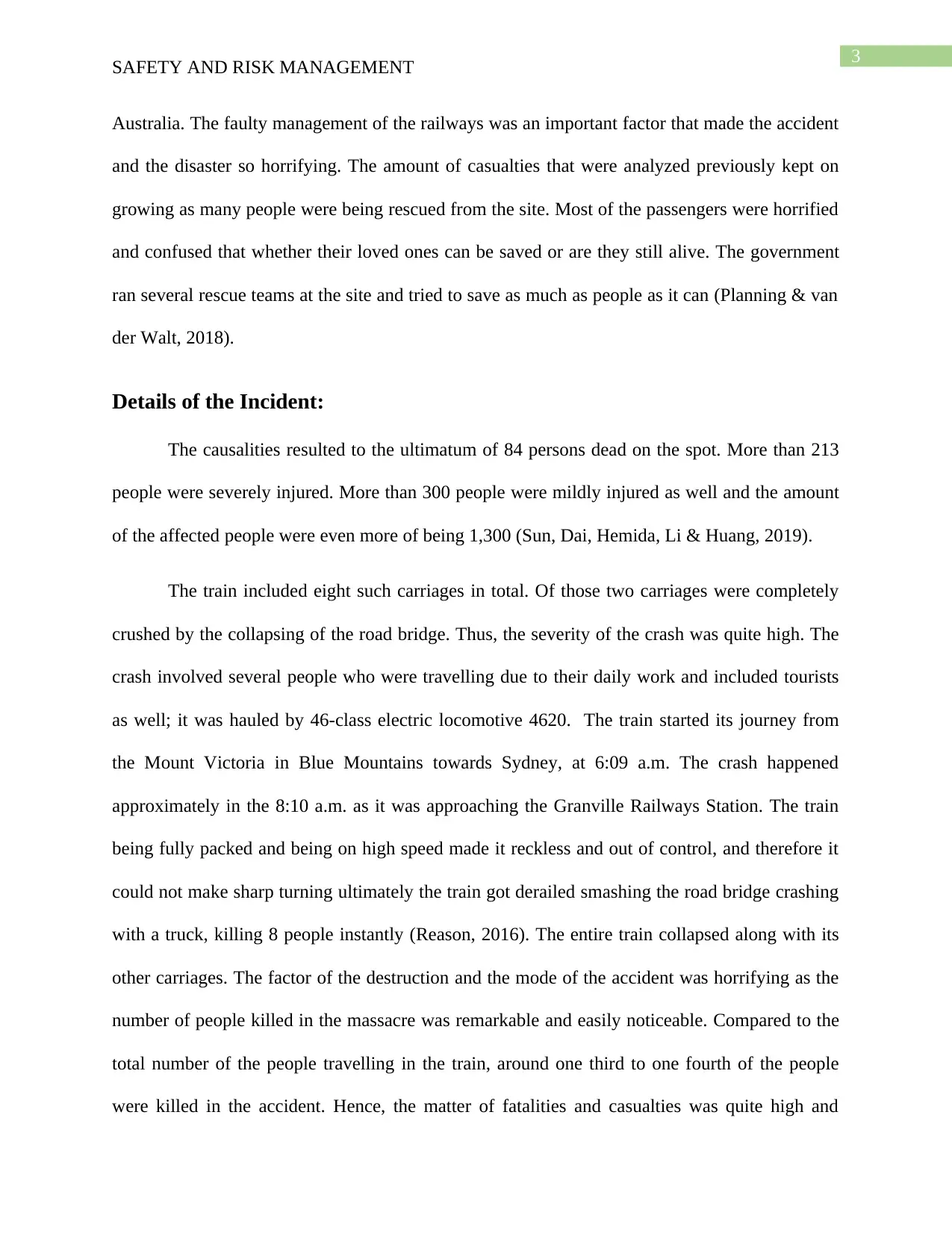
3
SAFETY AND RISK MANAGEMENT
Australia. The faulty management of the railways was an important factor that made the accident
and the disaster so horrifying. The amount of casualties that were analyzed previously kept on
growing as many people were being rescued from the site. Most of the passengers were horrified
and confused that whether their loved ones can be saved or are they still alive. The government
ran several rescue teams at the site and tried to save as much as people as it can (Planning & van
der Walt, 2018).
Details of the Incident:
The causalities resulted to the ultimatum of 84 persons dead on the spot. More than 213
people were severely injured. More than 300 people were mildly injured as well and the amount
of the affected people were even more of being 1,300 (Sun, Dai, Hemida, Li & Huang, 2019).
The train included eight such carriages in total. Of those two carriages were completely
crushed by the collapsing of the road bridge. Thus, the severity of the crash was quite high. The
crash involved several people who were travelling due to their daily work and included tourists
as well; it was hauled by 46-class electric locomotive 4620. The train started its journey from
the Mount Victoria in Blue Mountains towards Sydney, at 6:09 a.m. The crash happened
approximately in the 8:10 a.m. as it was approaching the Granville Railways Station. The train
being fully packed and being on high speed made it reckless and out of control, and therefore it
could not make sharp turning ultimately the train got derailed smashing the road bridge crashing
with a truck, killing 8 people instantly (Reason, 2016). The entire train collapsed along with its
other carriages. The factor of the destruction and the mode of the accident was horrifying as the
number of people killed in the massacre was remarkable and easily noticeable. Compared to the
total number of the people travelling in the train, around one third to one fourth of the people
were killed in the accident. Hence, the matter of fatalities and casualties was quite high and
SAFETY AND RISK MANAGEMENT
Australia. The faulty management of the railways was an important factor that made the accident
and the disaster so horrifying. The amount of casualties that were analyzed previously kept on
growing as many people were being rescued from the site. Most of the passengers were horrified
and confused that whether their loved ones can be saved or are they still alive. The government
ran several rescue teams at the site and tried to save as much as people as it can (Planning & van
der Walt, 2018).
Details of the Incident:
The causalities resulted to the ultimatum of 84 persons dead on the spot. More than 213
people were severely injured. More than 300 people were mildly injured as well and the amount
of the affected people were even more of being 1,300 (Sun, Dai, Hemida, Li & Huang, 2019).
The train included eight such carriages in total. Of those two carriages were completely
crushed by the collapsing of the road bridge. Thus, the severity of the crash was quite high. The
crash involved several people who were travelling due to their daily work and included tourists
as well; it was hauled by 46-class electric locomotive 4620. The train started its journey from
the Mount Victoria in Blue Mountains towards Sydney, at 6:09 a.m. The crash happened
approximately in the 8:10 a.m. as it was approaching the Granville Railways Station. The train
being fully packed and being on high speed made it reckless and out of control, and therefore it
could not make sharp turning ultimately the train got derailed smashing the road bridge crashing
with a truck, killing 8 people instantly (Reason, 2016). The entire train collapsed along with its
other carriages. The factor of the destruction and the mode of the accident was horrifying as the
number of people killed in the massacre was remarkable and easily noticeable. Compared to the
total number of the people travelling in the train, around one third to one fourth of the people
were killed in the accident. Hence, the matter of fatalities and casualties was quite high and
Paraphrase This Document
Need a fresh take? Get an instant paraphrase of this document with our AI Paraphraser

4
SAFETY AND RISK MANAGEMENT
massive. Thus, the number of the people travelling in the train were surveyed and taken care of,
as most of the people died or were severely injured due to the accident. The passengers were
trapped in the carriages and they could not get out of the carriage and had to wait for the rescue
teams to arrive. The people had to wait for several hours. They were all trapped in the train and
were unable get out of there. It was a serious situation as the carriages were hanging from the
road bridge. The causalities mainly had fractured limbs and torso (Filtness & Naweed, 2017).
Many died due to the crush syndrome as the boulders of rocks and concrete fell on them. Hence,
the number of passengers were severely high due to the accident. This resulted in changing the
procedures of rescuing the people as the accident happened in a very clumsy way and area was
completely turned to ruins creating a huge mess including the road bridge and the railway
compartments. The rescuers faced great difficulties as the parts of the bridge was still collapsing
and the broken parts were still falling. It was a challenging situation as there were boulders of
rocks were still falling down (Dhanabalu, Sugumar, Suryaprakash & VijayAnand, 2015, March).
Role of the Faulty Breaches:
The reason behind the accident is the number of faulty breaches that occurred as the train
was travelling from Mount Victoria to Sydney, Granville Station. The amount of the passengers
boarding the train was always a fault in the safety breach. As the number of the passengers
boarding the train must be kept in account and the people travelling in the compartments ought to
be made limited, as there have been previously lot of problems that grew due to the overloading
of the trains and making it prone to crash and accidents (Parkinson, Bamford & Kandola, 2016).
The accident that happened, had one of the factor of overloading of the train, therefore the train
could not maintain its pace and the momentum in which it was travelling. Thus the factor of the
faulty operations can be sited as precautions had not been taken to make the journey of the train
SAFETY AND RISK MANAGEMENT
massive. Thus, the number of the people travelling in the train were surveyed and taken care of,
as most of the people died or were severely injured due to the accident. The passengers were
trapped in the carriages and they could not get out of the carriage and had to wait for the rescue
teams to arrive. The people had to wait for several hours. They were all trapped in the train and
were unable get out of there. It was a serious situation as the carriages were hanging from the
road bridge. The causalities mainly had fractured limbs and torso (Filtness & Naweed, 2017).
Many died due to the crush syndrome as the boulders of rocks and concrete fell on them. Hence,
the number of passengers were severely high due to the accident. This resulted in changing the
procedures of rescuing the people as the accident happened in a very clumsy way and area was
completely turned to ruins creating a huge mess including the road bridge and the railway
compartments. The rescuers faced great difficulties as the parts of the bridge was still collapsing
and the broken parts were still falling. It was a challenging situation as there were boulders of
rocks were still falling down (Dhanabalu, Sugumar, Suryaprakash & VijayAnand, 2015, March).
Role of the Faulty Breaches:
The reason behind the accident is the number of faulty breaches that occurred as the train
was travelling from Mount Victoria to Sydney, Granville Station. The amount of the passengers
boarding the train was always a fault in the safety breach. As the number of the passengers
boarding the train must be kept in account and the people travelling in the compartments ought to
be made limited, as there have been previously lot of problems that grew due to the overloading
of the trains and making it prone to crash and accidents (Parkinson, Bamford & Kandola, 2016).
The accident that happened, had one of the factor of overloading of the train, therefore the train
could not maintain its pace and the momentum in which it was travelling. Thus the factor of the
faulty operations can be sited as precautions had not been taken to make the journey of the train
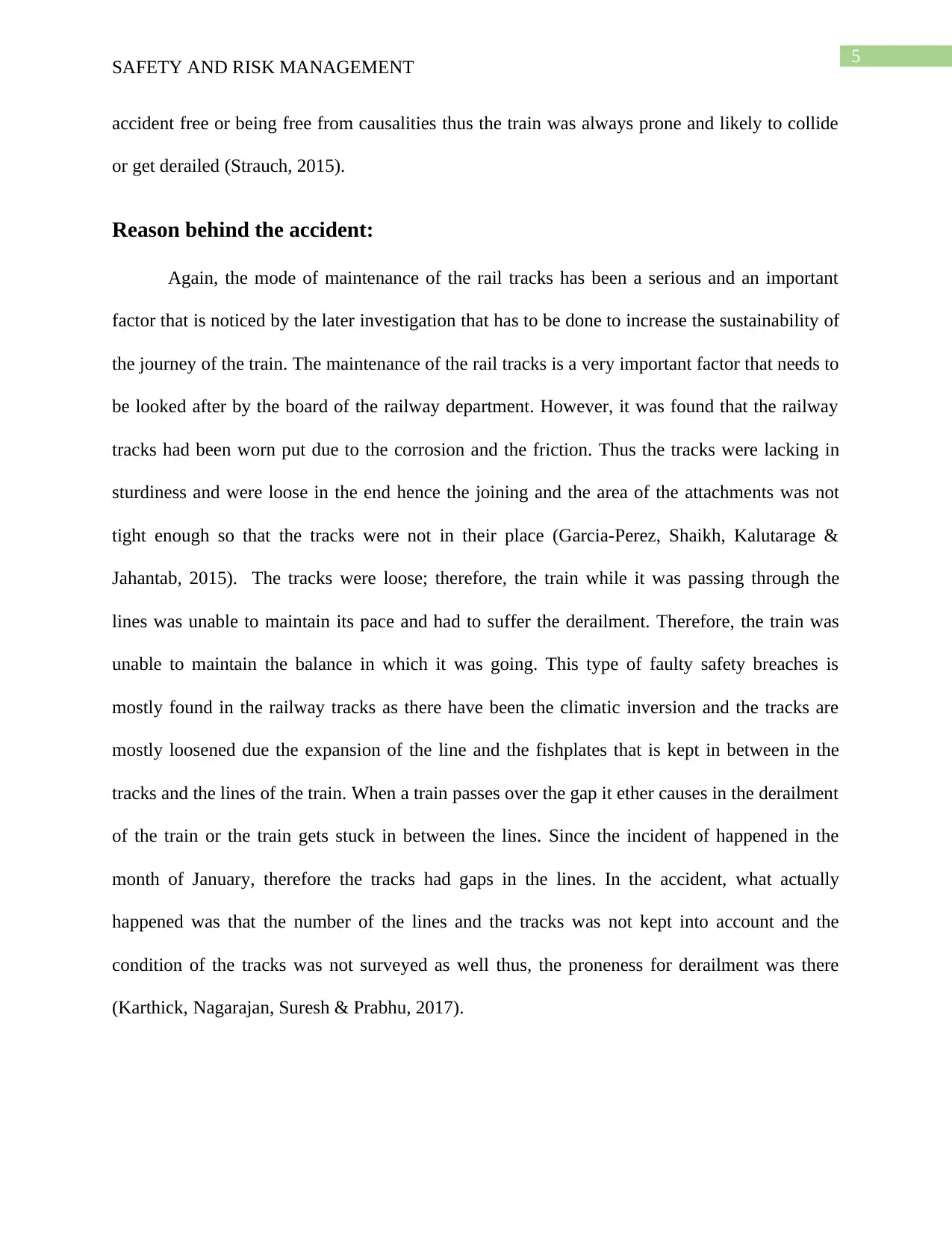
5
SAFETY AND RISK MANAGEMENT
accident free or being free from causalities thus the train was always prone and likely to collide
or get derailed (Strauch, 2015).
Reason behind the accident:
Again, the mode of maintenance of the rail tracks has been a serious and an important
factor that is noticed by the later investigation that has to be done to increase the sustainability of
the journey of the train. The maintenance of the rail tracks is a very important factor that needs to
be looked after by the board of the railway department. However, it was found that the railway
tracks had been worn put due to the corrosion and the friction. Thus the tracks were lacking in
sturdiness and were loose in the end hence the joining and the area of the attachments was not
tight enough so that the tracks were not in their place (Garcia-Perez, Shaikh, Kalutarage &
Jahantab, 2015). The tracks were loose; therefore, the train while it was passing through the
lines was unable to maintain its pace and had to suffer the derailment. Therefore, the train was
unable to maintain the balance in which it was going. This type of faulty safety breaches is
mostly found in the railway tracks as there have been the climatic inversion and the tracks are
mostly loosened due the expansion of the line and the fishplates that is kept in between in the
tracks and the lines of the train. When a train passes over the gap it ether causes in the derailment
of the train or the train gets stuck in between the lines. Since the incident of happened in the
month of January, therefore the tracks had gaps in the lines. In the accident, what actually
happened was that the number of the lines and the tracks was not kept into account and the
condition of the tracks was not surveyed as well thus, the proneness for derailment was there
(Karthick, Nagarajan, Suresh & Prabhu, 2017).
SAFETY AND RISK MANAGEMENT
accident free or being free from causalities thus the train was always prone and likely to collide
or get derailed (Strauch, 2015).
Reason behind the accident:
Again, the mode of maintenance of the rail tracks has been a serious and an important
factor that is noticed by the later investigation that has to be done to increase the sustainability of
the journey of the train. The maintenance of the rail tracks is a very important factor that needs to
be looked after by the board of the railway department. However, it was found that the railway
tracks had been worn put due to the corrosion and the friction. Thus the tracks were lacking in
sturdiness and were loose in the end hence the joining and the area of the attachments was not
tight enough so that the tracks were not in their place (Garcia-Perez, Shaikh, Kalutarage &
Jahantab, 2015). The tracks were loose; therefore, the train while it was passing through the
lines was unable to maintain its pace and had to suffer the derailment. Therefore, the train was
unable to maintain the balance in which it was going. This type of faulty safety breaches is
mostly found in the railway tracks as there have been the climatic inversion and the tracks are
mostly loosened due the expansion of the line and the fishplates that is kept in between in the
tracks and the lines of the train. When a train passes over the gap it ether causes in the derailment
of the train or the train gets stuck in between the lines. Since the incident of happened in the
month of January, therefore the tracks had gaps in the lines. In the accident, what actually
happened was that the number of the lines and the tracks was not kept into account and the
condition of the tracks was not surveyed as well thus, the proneness for derailment was there
(Karthick, Nagarajan, Suresh & Prabhu, 2017).
⊘ This is a preview!⊘
Do you want full access?
Subscribe today to unlock all pages.

Trusted by 1+ million students worldwide

6
SAFETY AND RISK MANAGEMENT
Changes made as precautionary measures:
After the incident of the massacre, there have been many changes in the policies and the
curriculum of the train schedules. Certain changes were made in the implementation of the safety
procedures. The government kept track of the various busy tracks and the lines of railway, which
could be allowed and maintained. This concern prevented any further accidents and other
chances of similar kind of situations from happening. The government maintained and controlled
the number of the passengers to be boarding the train from certain station. Measures were taken
to increase in the security of the railway stations and the carriages (Hollnagel, 2016).
Conclusion:
Thus, the government and the railway department managed to increase the security and
the concerns of the railways as well as update and upgrade the facilities. This made the railway
service in Australia more stable and secured. The number of causalities were severe; still the
situation was handled well. The faultiness of the safety breaches has always been a concern to
the context of train accidents. In this case, the faultiness or the failure of them cost so many lives.
Therefore, the government took serious actions to prevent any such problems afterwards.
SAFETY AND RISK MANAGEMENT
Changes made as precautionary measures:
After the incident of the massacre, there have been many changes in the policies and the
curriculum of the train schedules. Certain changes were made in the implementation of the safety
procedures. The government kept track of the various busy tracks and the lines of railway, which
could be allowed and maintained. This concern prevented any further accidents and other
chances of similar kind of situations from happening. The government maintained and controlled
the number of the passengers to be boarding the train from certain station. Measures were taken
to increase in the security of the railway stations and the carriages (Hollnagel, 2016).
Conclusion:
Thus, the government and the railway department managed to increase the security and
the concerns of the railways as well as update and upgrade the facilities. This made the railway
service in Australia more stable and secured. The number of causalities were severe; still the
situation was handled well. The faultiness of the safety breaches has always been a concern to
the context of train accidents. In this case, the faultiness or the failure of them cost so many lives.
Therefore, the government took serious actions to prevent any such problems afterwards.
Paraphrase This Document
Need a fresh take? Get an instant paraphrase of this document with our AI Paraphraser
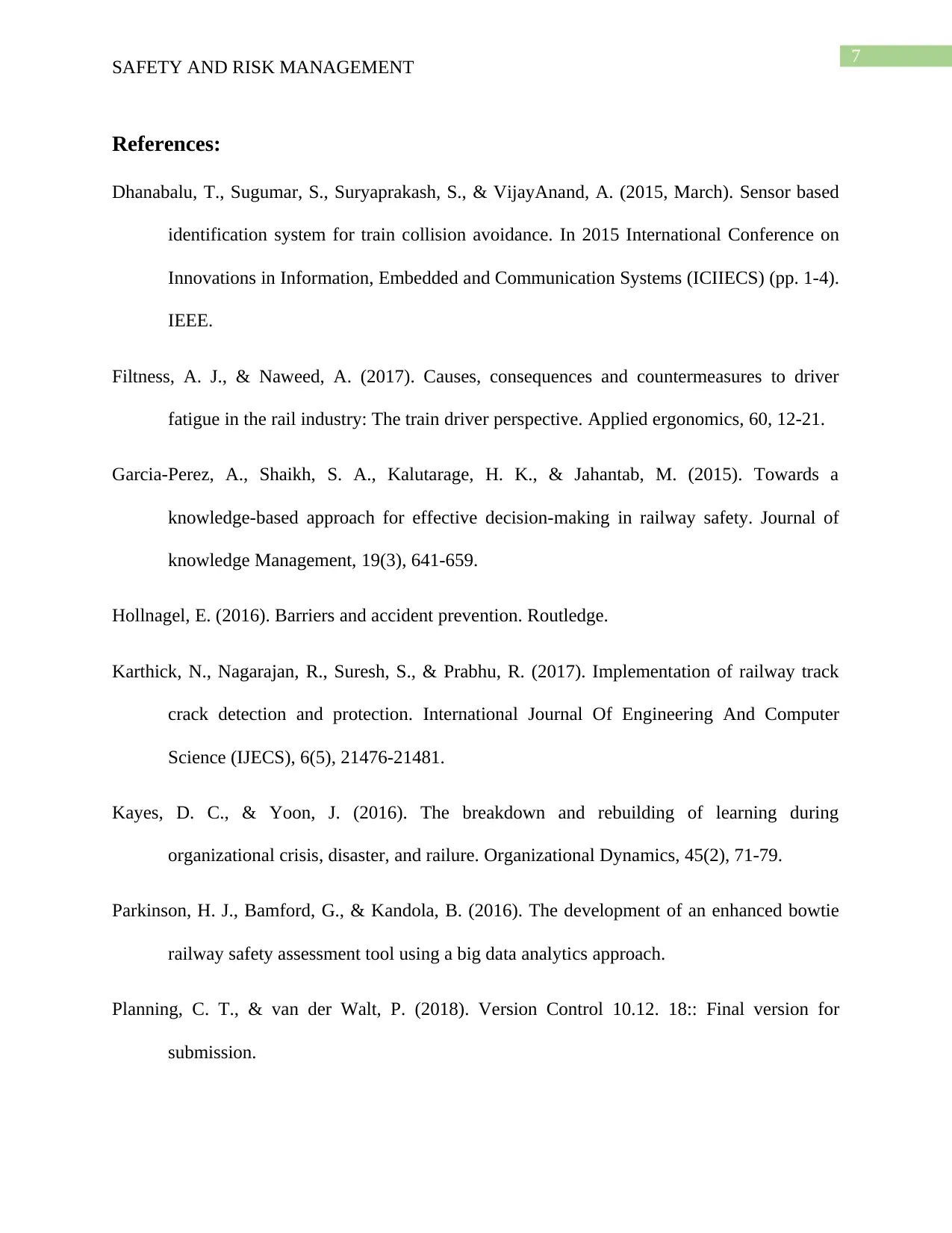
7
SAFETY AND RISK MANAGEMENT
References:
Dhanabalu, T., Sugumar, S., Suryaprakash, S., & VijayAnand, A. (2015, March). Sensor based
identification system for train collision avoidance. In 2015 International Conference on
Innovations in Information, Embedded and Communication Systems (ICIIECS) (pp. 1-4).
IEEE.
Filtness, A. J., & Naweed, A. (2017). Causes, consequences and countermeasures to driver
fatigue in the rail industry: The train driver perspective. Applied ergonomics, 60, 12-21.
Garcia-Perez, A., Shaikh, S. A., Kalutarage, H. K., & Jahantab, M. (2015). Towards a
knowledge-based approach for effective decision-making in railway safety. Journal of
knowledge Management, 19(3), 641-659.
Hollnagel, E. (2016). Barriers and accident prevention. Routledge.
Karthick, N., Nagarajan, R., Suresh, S., & Prabhu, R. (2017). Implementation of railway track
crack detection and protection. International Journal Of Engineering And Computer
Science (IJECS), 6(5), 21476-21481.
Kayes, D. C., & Yoon, J. (2016). The breakdown and rebuilding of learning during
organizational crisis, disaster, and railure. Organizational Dynamics, 45(2), 71-79.
Parkinson, H. J., Bamford, G., & Kandola, B. (2016). The development of an enhanced bowtie
railway safety assessment tool using a big data analytics approach.
Planning, C. T., & van der Walt, P. (2018). Version Control 10.12. 18:: Final version for
submission.
SAFETY AND RISK MANAGEMENT
References:
Dhanabalu, T., Sugumar, S., Suryaprakash, S., & VijayAnand, A. (2015, March). Sensor based
identification system for train collision avoidance. In 2015 International Conference on
Innovations in Information, Embedded and Communication Systems (ICIIECS) (pp. 1-4).
IEEE.
Filtness, A. J., & Naweed, A. (2017). Causes, consequences and countermeasures to driver
fatigue in the rail industry: The train driver perspective. Applied ergonomics, 60, 12-21.
Garcia-Perez, A., Shaikh, S. A., Kalutarage, H. K., & Jahantab, M. (2015). Towards a
knowledge-based approach for effective decision-making in railway safety. Journal of
knowledge Management, 19(3), 641-659.
Hollnagel, E. (2016). Barriers and accident prevention. Routledge.
Karthick, N., Nagarajan, R., Suresh, S., & Prabhu, R. (2017). Implementation of railway track
crack detection and protection. International Journal Of Engineering And Computer
Science (IJECS), 6(5), 21476-21481.
Kayes, D. C., & Yoon, J. (2016). The breakdown and rebuilding of learning during
organizational crisis, disaster, and railure. Organizational Dynamics, 45(2), 71-79.
Parkinson, H. J., Bamford, G., & Kandola, B. (2016). The development of an enhanced bowtie
railway safety assessment tool using a big data analytics approach.
Planning, C. T., & van der Walt, P. (2018). Version Control 10.12. 18:: Final version for
submission.

8
SAFETY AND RISK MANAGEMENT
Rapattoni, F., Dauth, J., Muscat, J., & Prasad, P. (2017, April). AS (NZS) 5100-2017: derailed
train collisions. Leading safety provisions in bridge design to prevent disasters. In
Austroads Bridge Conference, 10th, 2017, Melbourne, Victoria, Australia.
Reason, J. (2016). Managing the risks of organizational accidents. Routledge.
Strauch, B. (2015). Can we examine safety culture in accident investigations, or should we?.
Safety Science, 77, 102-111.
Sun, Z., Dai, H., Hemida, H., Li, T., & Huang, C. (2019). Safety of high-speed train passing by
windbreak breach with different sizes. Vehicle System Dynamics, 1-18.
SAFETY AND RISK MANAGEMENT
Rapattoni, F., Dauth, J., Muscat, J., & Prasad, P. (2017, April). AS (NZS) 5100-2017: derailed
train collisions. Leading safety provisions in bridge design to prevent disasters. In
Austroads Bridge Conference, 10th, 2017, Melbourne, Victoria, Australia.
Reason, J. (2016). Managing the risks of organizational accidents. Routledge.
Strauch, B. (2015). Can we examine safety culture in accident investigations, or should we?.
Safety Science, 77, 102-111.
Sun, Z., Dai, H., Hemida, H., Li, T., & Huang, C. (2019). Safety of high-speed train passing by
windbreak breach with different sizes. Vehicle System Dynamics, 1-18.
⊘ This is a preview!⊘
Do you want full access?
Subscribe today to unlock all pages.

Trusted by 1+ million students worldwide
1 out of 9
Related Documents
Your All-in-One AI-Powered Toolkit for Academic Success.
+13062052269
info@desklib.com
Available 24*7 on WhatsApp / Email
![[object Object]](/_next/static/media/star-bottom.7253800d.svg)
Unlock your academic potential
Copyright © 2020–2025 A2Z Services. All Rights Reserved. Developed and managed by ZUCOL.





